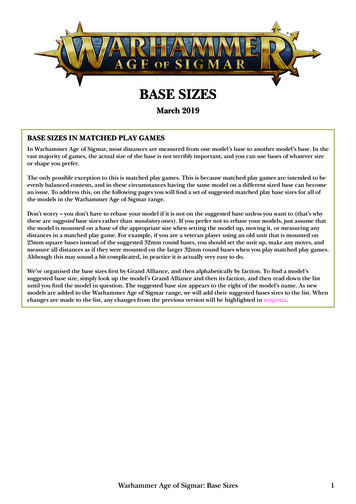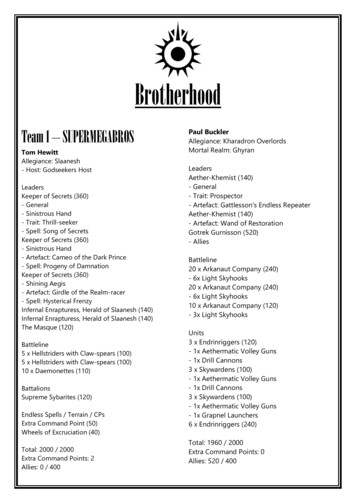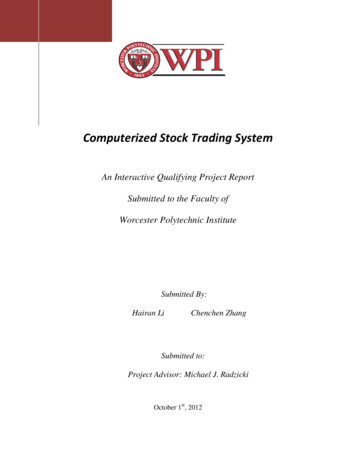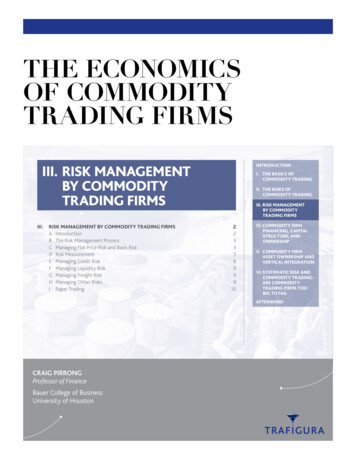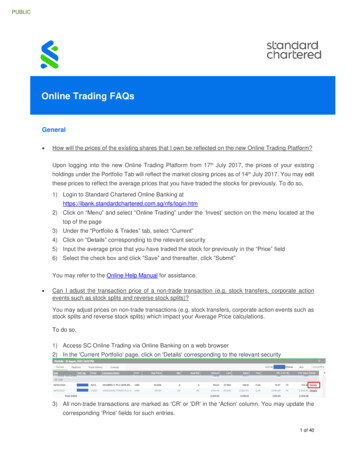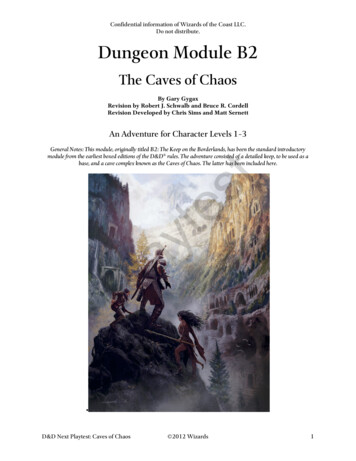
Transcription
Tradingin ChaosThe impact at home and abroadof illegal logging in the DRC
Executive summaryThe forests of the Congo Basin comprise thesecond-largest rainforested area in the world. Knownvariously as the earth’s second lung or “the lungs ofAfrica” they play a key role in regulating the earth’sclimate and provide a home and livelihood to millionsof people and rare and endangered wildlife.The Democratic Republic of Congo (DRC) is home tothe large majority of this forest network but corruptionand a lack of political will are among the reasonswhy these forests are increasingly under threat andwhy a potentially valuable resource continues tobe squandered.The country’s logging sector is in a state of organisedchaos – a chaos to a large extent engineered byofficials and companies for their own benefit. Theinstitutions that should govern the forestry sector andenforce the law are not functioning. There is a woefullack of transparency, with logging contracts not madepublic or only made public years after they weresigned (in violation of national law) 1 and no reliableofficial data available on permits, production andexports. Corruption is endemic and iIlegal activities inindustrial logging concessions are the norm.Chief among the companies wreaking this havoc isCotrefor, a Lebanese-owned company that has beenlogging in the country since 2011 but before that datewas operating under the name Trans M. GreenpeaceAfrica has been among those that have consistentlyexposed the irregularities in its logging concessionsand the impunity with which the company is allowedto operate.Tradingin ChaosGreenpeace Africa spent two years investigatingCotrefor’s logging concessions and the operationstherein as well as tracking how its timber is traded2Cotrefor logs stacked in a port inChina. Greenpeace East Asia. Simon Limand exported to the world’s ports. The results ofthese investigations reveal a shocking record ofemployee mistreatment, unpaid taxes, rampantirregularities in operational procedure with regardsto felling trees and exceeding allocated quotas ofendangered species such as Afrormosia that arepermitted to be logged.The company’s operations are contributing to thedestruction of vital habitat of the endangered bonobo,one of man’s closes relatives and only found in theDRC. Communities are also increasingly the oneswho suffer as Cotrefor consistently fails to fulfil theterms of social contracts signed prior to logging inits concessions.There is a plethora of suspect timber from Cotreforbeing placed on international markets. Yet for thoseexports to occur there must be importers willing totrade in timber of illegal (or at least dubious) origin,end users willing to purchase it, and governments inemerging and developed nations unwilling or unableto take effective action to prevent those transactions.Greenpeace’s research discovered shipments oftimber heading to countries as diverse as the UK,Spain, Portugal, the US and China among others.Such trade violates numerous regulations and callsinto question the effectiveness of laws such as theEuropean Timber Regulation (EUTR) if they are notproperly used to prevent illegal Congo Basin timberbeing placed on the European market.Cotrefor’s operations are a microcosm of the chaosthat pervades the DRC logging sector and anexample of why if this impunity is allowed to continue,it will be Congo’s forests, forest communities andwildlife that will suffer.Tradingin ChaosExtensive research carried outby Greenpeace and a numberof other organisations shows arange of fundamental problemsin the DRC’s industrial forestrysector that combine to threatenthe country’s irreplaceablenatural heritage.3
Cotrefor: loggingillegally, threateningrare speciesIllegal titlesThe 2002 DRC Forest Code abolished the existingtypes of industrial logging title, replacing them withthe Contrat de concession forestière (CCF), to whichexisting titles were to be converted if they passedthe requirements of a legal review. In May 2002 amoratorium on the awarding of new industrial titleswas signed, but was immediately violated. In July2003 the World Bank estimated the total number ofnew titles awarded since the moratorium as coveringsome 9.5 million ha. 2 In 2005 the legal reviewof existing titles was launched with finance frominternational donors.Tradingin ChaosIn November 2008 the Interministerial Commission(IMC) in charge of the review found all three titles heldby Trans-M (the former name of Cotrefor, changedin March 20113) to have been awarded in violation ofthe moratorium and recommended their cancellation.Environment Minister José Endundo duly cancelledthe titles in January 2009 – only to annul his owncancellation the following year. In April 2010,although the 2005 presidential decree regulating theconversion process stipulates that the Minister isbound by IMC decisions, Endundu decreed all threetitles re-eligible for conversion. The Minister’s illegalconfirmation of Trans-M’s titles (along with severalother titles) was announced at a January 2011 pressconference.4 Concession contracts (CCFs) weresigned in August and October.54MECNT ((Ministry of the Environment, Nature,Conservation and Tourism) now MEDD (Ministry forthe Environment and Sustainable development))published its final list of converted industrial loggingtitles in August 2014. 6 Cotrefor is listed as the formerTrans-M and is said to hold two titles: CCF 009/11in Befale Territory, Equateur Province, with an areaof 275,064 ha and CCF 018/11 in Banalia Territory,Orientale Province, with an area of 261,753 ha.These titles were converted from the old Garantiesd’approvisionnement (GAs) 034/05 and 033/05respectively. The third title illegally confirmed by theEnvironment Minister has since been given back tothe state: GA 035/05 in Bumba Territory, EquateurProvince, with an area of 206,029 ha.Non-payment of taxesIn 2013 Global Witness published a report showingthat the vast majority of forest taxes in the DRCwere not paid in 2012. 7 The same report mentionsCotrefor as an example of non-payment, calculatingthat it paid only about half of what it should havecontributed to the state’s coffers. 8Bonobos live only in the DRC, in small populationssouth of the Congo river, and their total numbers arenot yet well established. The key threat to the speciesis commercial poaching, which is especially harmfulbecause the bonobo is slow-breeding. It is widelyaccepted that poaching is facilitated by the loggingindustry opening up access to previously inaccessibleforest areas. Other threats include habitat destructionby commercial logging and agriculture. These threatsare recorded to “put all populations at risk irrespectiveof the conservation status of the area”. 25Afrormosia LoggingIn April 2014 the CITES Secretariat notified Parties ofthe existence of a “large number of fake or falsified[export] permits apparently issued by the DemocraticRepublic of the Congo”, and provided a long list of“permits that are unaccounted for”, meaning thatit is not clear whether the CITES authorities in theDRC have correctly issued them The Secretariatrequested that Parties contact it to check the validityof any CITES permits from the DRC before acceptingthem. 18 Cotrefor holds several of those unaccountedfor CITES permits. 19In 2015 Cotrefor filed an inventory for CCF 018/11and on that basis is allowed to export almost9,000 m3 RWE of afrormosia in 2015. 20 The yearbefore, an excessive afrormosia harvesting volumewas authorised by MECNT (see box), of whichnearly half (21,245 m3) was allocated to Cotrefor.This was exceeding CCF 018/11’s ‘plan de gestion’sustainable annual afrormosia volume (16,298 m3)by nearly 5,000 m3. 21AFRORMOSIA LOGGINGThe tree species afrormosia (Pericopsis elata) is listed on Appendix II of CITES and has additionally beenlisted as ‘Endangered’ in the IUCN’s Red List of Endangered species since 1998 because of overexploitationand soaring levels of international trade.In the DRC, which holds the largest remaining stocks of the species, 9 inadequate law enforcement andwidespread illegal logging mean that afrormosia exploitation and trade occurs with very little control. Whilelimited quantities of the species may be logged, any timber to be exported needs to be accompanied byan export permit. That permit is supplemented by a certificate of origin guaranteeing that the timber washarvested legally, which must be checked by the CITES authority in the country of harvest. Since thischecking is not done effectively in the DRC, the legality of the afrormosia cannot be guaranteed, even whenexported with a CITES export permit.CITES has taken some measures to address these issues, 10 but they have proved inadequate. GreenpeaceInternational and Belgium have detected several illegal and suspect batches of afrormosia timber enteringthe EU market over the past few years. 11 On-the-ground enforcement remains poor, national CITESauthorities lack capacity, and there is no effective traceability system in place. Without an overall suspensionof trade in the species, CITES will continue to fail in its mission to protect afrormosia against overexploitationdriven by international demand.Logging in bonobo habitatThe Cotrefor concession CCF 009/11 is within therange of the protected great ape species bonobo 22(Pan paniscus, classified as Endangered by IUCN 23)and lies inside the ecologically sensitive Maringa–Lopori–Wamba landscape. According to the AfricanWildlife Foundation (AWF), this landscape holdsa range of other rare species of flora and fauna inaddition to the bonobo, such as Congo peafowl(Afropavo congensis, classified as Vulnerableby IUCN), forest elephant (Loxodonta cyclotis,Vulnerable), African golden cat (Profelis aurata, NearThreatened) and giant pangolin (Manis gigantea,Vulnerable) 24 Cotrefor’s concession area borders animportant conservation area for bonobos managedby AWF, the Lomako-Yokokala faunal reserve.In 2014 MECNT authorised industrial loggers in the DRC to log at least 55,373 m3 of afrormosia 12 despite theCITES national export quota being a mere 25,000 m3. 13 For 2015 a new measure aimed at controlling loggingof afrormosia was introduced, 14 requiring companies to file inventories in order to be able to export it. Onthe basis of those inventories, the national export quota has been set at 23,240 m3 roundwood equivalent. 15However, inventories for more concession contracts are being prepared, so there is no guarantee the DRCgovernment will not increase the export quota during the year. Also, companies’ inventories have not yetbeen independently verified, so it is not clear if they provide any guarantees of responsible harvesting levels.Furthermore, the DRC government has introduced a dubious ‘transitional additional quota’ of 30,290 m3for 2014, in order to enable companies to get rid of huge stocks that cannot be sold under the stricter 2015requirements. 16As an endangered species regulated by CITES, afrormosia can only be logged with a special yearly cuttingpermit (L’autorisation de coupe industrielle de bois d’oeuvre spéciale). 17 Contrary to this law the DRCgovernment regularly authorises logging of afrormosia with ordinary cutting permits.Tradingin ChaosSince being awarded titles to industrial loggingconcessions in the DRC, Cotrefor has consistentlyundertaken illegal activities and its operations haveposed serious threats both to wildlife and to localcommunities. Here are just some of the issues.Afrormosia, a highly valued tropical hardwood,stands tall in the village of Yafunga. Afrormosiais a protected tree species whose internationaltrade is strictly regulated (listed under CITESAppendix II). Such trees are logged bycompanies including Cotrefor. Approximately40 million people in the DRC depend onthe rainforest for their basic needs, such asmedicine, food or shelter. Jiro Ose5
Cotreforconcessions,DRC060120 kmCotrefor consessionsForest cover change 2000-2013Forest coverGA 035/05Boli SudIt is widely accepted thatpoaching is facilitated bythe logging industry openingup access to previouslyinaccessible forest areas.BumbaEquateurOrientaleBanaliaCCF 018/11CCF 009/11Baulu!6A bonobo in a bonobo rehabilitationcenter near Kinshasa. Bonoboswere the last of the great apes tobe discovered and live exclusivelyin the Democratic Republic of theCongo. They are considered to beman’s closest relative and organisethemselves in sophisticated socialgroups. They are endangeredfrom hunting and loss of habitat.Expansion of logging into remainingareas of intact forests in theDemocratic Republic of Congowill destroy globally critical carbonreserves and impact biodiversity. Kate DavisonTradingin ChaosTradingin ChaosBefale7
Cotrefor: evidencefrom the fieldVisits to CCF 009/11, Befale Territory,Equateur ProvinceWith the help of local partners, Greenpeace Africa(hereinafter Greenpeace) conducted researchmissions to CCF 009/11 in December 2014and February 2015. Evidence was gathered of awide range of illegalities and environmental andsocial impacts.Disturbance of protected speciesGreenpeace researchers talked to staff at theLomako-Yokokala faunal reserve, who were veryconcerned that Cotrefor had opened roads near thereserve, with a subsequent increase in poaching. Thereserve staff also observed animals being driven awayby the noise of the chainsaws. Furthermore theyreported a massive abundance of bonobos in thebuffer zone between the reserve and the concessionarea, as well as the presence of forest elephant dung.The communities living in the area confirmed thatbonobos are seen in the concession area and in thebuffer zone next to the concession around the Bololoriver. Greenpeace also talked to several Cotreforstaff who told us that due to the lack of provisionof food to the workers while they are in the forest(they receive a modest cash allowance but there isnowhere on site to purchase food), they are forced tohunt in order to feed themselves.Tradingin ChaosGreenpeace concludes that Cotrefor’s industriallogging practices are disturbing the bonobo’s habitatas well as increasing poaching pressure, with thecompany’s failure to provide workers with food alsocontributing to the latter effect. This appears to bein clear violation of the stipulations of the Guideopérationnel EFIR (July 2007), 26 which lays downguidance for reduced impact logging operations andarticle 11 in the concession contract. 278Violation of workers’ rightsCorruptionThe Greenpeace investigation discovered thatworkers are transported to the forest sites in askip truck.Greenpeace investigators interviewed a range ofgovernment officials and customary leaders in theconcession area. Six of these individuals confirmedthat they received monthly payments from Cotrefor,which they referred to as their “prime” (bonus). Thisappeared to be an instance of corruption, as thesepayments were additional to taxes due and permittedpayments to local bodies. One respondent saidthat payments of the order of 25,000 or 30,000 FC( 25 – 30) a month were made to such individualswhen it was time for them to sign transportauthorisations for consignments of logs, and thatonce they had signed the documents they wouldreceive an additional bag of salt and 10,000 FC “fortheir mothers”. This represents a potential violationof the criminal code (Code penal Congolais 2004),articles 147 bis and 148. 31Greenpeace investigators found an information panelwith rules for workers in the base camp at Baulu,several of which flouted the basic legal principlethat a group cannot be punished for the action ofan individual, for example stipulating that failure onthe part of a supervisor to monitor all activities atthe worksite during working hours would result indisciplinary action against the whole supervisoryteam, and that in the event of a theft of companyproperty within the worksite, punishment would beextended to all employees. 28Workers and the local management committee(a committee that administers cahier des chargesmatters on behalf of the community) explained thatCotrefor has a system it calls a campagne (campaign)which comes into operation when the company isunder time pressure to get all the trees covered by aparticular permit logged. During such a campagne,workers are sent to the forest for six days at atime in inhuman conditions, with only a tarpaulinto protect themselves from the rain, cold, snakes,mosquitos and other insects. As already mentioned,the company makes no adequate provision forworkers’ food, therefore making some of them resortto engage in poaching. The conditions described toGreenpeace appear to be clear violation of labourlaws (Code du travail of 16 October 2002, Articles 55,163, 170 and 201 29).Other regulations governing conditions in forestconcessions were also found to be violated. Forexample, conditions in the base camp at Bauluwere in breach of regulations governing adequateaccommodation, waste disposal and hygiene. Inaddition the Greenpeace field team witnessed seriouspollution of the river Maringa with human faeces, fueland lubricants from the base camp. The conditionsat the base camp, as well as the pollution found,appear to be flagrant violations of several articles 30of Ministerial Order 21 of 7 August 2008 on Facilitiesin Forest Concessions.Abandoned logsDuring the two field missions several abandoned logswere found. Abandoning logs is illegal and a verywasteful and destructive practice: felling trees that arenot then used represents unnecessary environmentaldamage, offers an opportunity for overharvestingif the volumes abandoned are not reported, anddeprives the state of the taxes due on each harvestedtree. The evidence demonstrates that there appear tohave been clear violations of Article 42 of MinisterialOrder 35 of 5 October 2006 on Forest Exploitation. 32Below-diameter loggingThe minimum diameter of trees permitted tobe logged is established officially by MEDDfor each species to prevent overharvesting,ensuring a healthy stock of trees for future loggingoperations. 33 However, companies in search of aquick profit engage in below-diameter logging. Forthe companies to be able to trade the resultantundersized logs requires either an absence ofofficial oversight or connivance on the part ofgovernment officials. During their December fieldmission Greenpeace investigators witnessed boatscarrying Cotrefor logs that included very small trees.During the February mission the investigators wereable to measure logs on Cotrefor trucks and at theworksite, of the species Bossé (Guarea cedrata)and Kosipo (Entandrophragma candollei), belowthe official minimum diameters of 60 cm and 80 cmrespectively. 34 This serves as evidence of furtherviolations of Article 42 of Ministerial Order 35 of 5October 2006 on Forest Exploitation. 35From top: Workers left to fendfor themselves in the forest.A monkey, killed by poachers.Tola wood abandoned in theforest GreenpeaceTradingin ChaosHaving established from some of the availableinformation detailed in the previous sectionthat Cotrefor’s logging activities merited closerinvestigation, and having conducted several previousvisits to forest areas associated with the company,Greenpeace Africa carried out a number of fieldmissions between 2013 and 2015 to assess thelegality and impacts of the company’s activities onthe ground.9
A Greenpeace-commissioned field mission inDecember 2013 and a Greenpeace France missionin August 2014 to the now deserted GA 035/05in Bumba territory showed that Cotrefor had leftthe area in 2013. Nevertheless the company hadleft behind evidence of unlawful and destructivelogging practices and a cavalier attitude to itssocial obligations.Unfulfilled cahiers des chargesA log that was felled in 2103 but hasbeen left to rot GreenpeaceYearly cutting permits signed during the yearof harvestDespite being contrary to forest law, this is a regularpractice. Yearly cutting permits (Autorisations decoupe industrielle de bois d’œuvre (ACIBOs)) shouldbe signed before the start of the calendar year ofharvest. A number of Cotrefor yearly permits for2013 and 2014 36 had been signed after the 31December deadline, in March and April of the yearof harvest. This appears to have contravened Article4 of Ministerial Order 11 of 12 April 2007 onCutting Permits. 37Several communities within the former concessionarea visited by Greenpeace France in August2014 explained that Cotrefor had failed to fulfil itsobligations set out in the cahiers des charges. Theformer president of the local management committeefrom Boli-Sud explained that in February 2013, whenhe asked Cotrefor to comply with the cahier descharges for his community, he was arrested, jailedfor ten days, released and jailed again. He had topay the police around 200,000 Congolese francs(around 180 or US 220) to secure his release.He told the Greenpeace field team that the socialcontract remained unfulfilled, with the community stillwaiting for road maintenance, a health centre andschools. 39 These failings appear to be clear evidenceof Cotrefor’s actions that are in violation of MinisterialOrder 28 of 7 August 2011 on Concession Templatesand Cahiers des Charges. 40Logging irregularitiesEvidence of other infractionsThe Greenpeace investigators also saw a May2014 letter from Cotrefor’s Secretary General tothe manager of the site at Baulu, reprimanding himover several legal and social issues for which he isresponsible. 38 In particular, the Secretary Generalreminded him to execute the company’s obligationsunder the cahier des charges (social contract– a compulsory agreement between a loggingcompany and a community or communities withinits concession area, in which certain material andother socio-economic benefits for the community arestipulated to be provided by the company) signedwith the community of Loma in 2010, including roadand bridge maintenance and the building of threeschools. He was also urged to ensure that otherrules were followed, such as safety standards fortransporting people in company boats, and the needto give contracts to workers who have worked for thecompany for a year without one.The 2014 Greenpeace field team also found evidenceof prohibited logging practices around the abandonedCotrefor logging area, including abandoned logs andharvesting within 50 m of streams. This indicates thatCotrefor had committed further violations of Article 42of Ministerial Order 35 of 5 October 2006 on ForestExploitation. 41Petition from communities exposing furtherviolationsIn November 2013 the village of Befale, incollaboration with a local NGO, published a petitionaddressed to the Prime Minister of the DRC 42 whosetext exposed a whole range of violations within CCF009/11, including violation of boundaries negotiatedwith the communities, failure to fulfil the socialobligations set out in the cahier des charges, failureto respect workers’ rights and failure to comply withlogging regulations.Tradingin ChaosOGF conducted an IM-FLEG field mission in October2013 in Cotrefor concession area CCF 018/11,Banalia Territory, Orientale Province. 45 It uncoveredevidence of a range of violations.10Unauthorised loggingThe most serious infraction found was loggingwithout authorisation 46 of at least 137 trees, mostly ofthe endangered species afrormosia. This constituteda violation of Article 97 of the Forest Code, 47 Article 7of Ministerial Order 35 of 5 October 2006 on ForestExploitation 48 and Articles 1 and 4 of Ministerial Order11 of 12 April 2007 on Cutting Permits. 49Other infractionsThe report goes on to give a long list of otherinfractions,50 including: Out of boundary logging. GPS analysis and fieldobservations by OGF show that Cotrefor hadbeen logging around 2 km beyond its concessionboundaries in an area held by another industriallogging company. This constituted a violationof Article 8 of Ministerial Order 36 of 5 October2006 on Management Plans. 51 Lack of application of Reduced Impact Loggingmeasures. OGF found that logging roads werenot closed off to deter poaching and future croptrees were not indicated in the cutting blocks.Marking and protecting future crop trees is acrucial part of responsible forest management,serving to preserve the economic value of theforest by maintaining a good timber stock.Failure to adhere to this approach depletes anddegrades the forest instead of managing it forfuture generations. OGF’s findings on this issueindicate that Cotrefor had committed violationsof Article 32 of Ministerial Order 35 of 5 October2006 on Forest Exploitation. 52 No physical delimitation of permit limits. Permitlimits were not delimited for the annual cuttingpermit 036/2013/PO/06 in operation at the timeof the field mission. This constituted a violation ofArticle 5 of Ministerial Order 11 of 12 April 2007on Cutting Permits. 53 Incorrect and absent marking of logs. A numberof logs in the forest and in Cotrefor’s log yardwere marked incorrectly or not at all. The lawdescribes very clearly when and how logs shouldbe marked: failure to mark logs correctly meansthat their origin cannot be established by officialseither in the DRC or in importing countries.Failure to mark logs can indicate laundering ofillegally harvested wood. This evidence meansthat Cotrefor had committed multiple violationsof Article 48 of Ministerial Order 35 of 5 October2006 on Forest Exploitation. 54 Logging of afrormosia without special permit.As an endangered species regulated by CITES,afrormosia can only be logged with a specialcutting permit (see page xx). However, Cotreforwas found to be logging afrormosia despitehaving only a ordinary permit. As a result, it wasin violation of Article 3 of Ministerial Order 11 of12 April 2007 on Cutting Permits. 55 Logging of non-authorised species. In additionto the logging of afrormosia, Cotrefor was foundto have systematically harvested over 100 m3of timber of species that it was not authorisedto cut because they were not included in thelogging permit that specifies all species to beharvested along with allowed harvest volumes.This constituted a violation of Article 19 ofMinisterial Order 35 of 5 October 2006 onForest Exploitation. 56 Failure to comply with cahier des charges.The local management committee explainedto the OGF mission that Cotrefor, as in itsother concessions, had failed to fulfil theobligations of the cahier des charges agreedwith the communities. For example, it had notconstructed the promised school and communityIT and social centre, nor did it provide informationon logging operations to the local managementcommittee. Accordingly, the company was inviolation of Article 89 of the 2002 Forest Code. 57OFFICIAL INSPECTION MISSIONSIn the DRC an Independent Monitor of Forest Law Enforcement and Governance (IM-FLEG) has been working since December 2010 to check forest operations in the field as well as to analyse and give recommendations on improving forest laws and their enforcement – an approach that has been adopted in a numberof Central African countries. In the DRC the IM-FLEG has an official mandate from the government and wasestablished with funding from international donors. Its field missions are conducted jointly with governmentofficials and its reports are published only after they have been discussed by a Reading Committee, including representatives of the DRC government, donor institutions, the forestry sector and civil society. TheUK-based non-profit organisation Resource Extraction Monitoring (REM) acted as IM-FLEG from December2010 to April 2013, 43 at which point the DRC-based Observatoire de la Gouvernance Forestière (OGF) 44 tookover the role, which it retains today. OGF has a partnership with the Field Legality Advisory Group, a regionalorganisation supporting independent forest monitors in the Congo Basin.Tradingin ChaosVisits to GA 035/05, Bumba Territory, EquateurProvinceThe role of the IM-FLEG is extremely important as a means of increasing transparency in the forestry sector,but its recommendations on improving governance and on penalising companies are rarely followed becauseof a lack of political will and the indifference of donors.11
Organized ChaosThe Democraticrepublic of Congo’sforestry sectorTradingin ChaosIn 2013 Greenpeace Russia’s mapping team,together with leading scientists and the WorldResources Institute, published findings froma model which predicts that intact forestlandscape degradation in the DRC will double thisdecade. 59 These researchers also found that the10-year forest degradation rate within designatedlogging permit areas was 3.8 times higher thanin other primary forest areas. While much of thedeforestation and degradation is undoubtedly dueto small-scale agriculture and artisanal logging forfuelwood and local timber needs, extensive researchcarried out by Greenpeace Africa and a number ofother organisations shows a range of fundamentalproblems in the DRC’s industrial forestry sectorthat combine to threaten the country’s irreplaceablenatural heritage.12A 2014 report by the UK-based think-thank ChathamHouse summarises the findings of a series of fieldinspections by the country’s Independent Monitor ofForest Law Enforcement and Governance (IM-FLEG),which it says offers a mere “snapshot or baseline ofthe scale of illegalities” in the DRC’s logging sector: In total, [the IM-FLEG] visited 21 industrial loggingsites between July 2011 and August 2012.This included 18 of the 28 industrial loggingconcessions that were active during the period(65%). The results demonstrate systematic illegalactivity and breaches of regulations by industrialloggers in the country. During these investigations, it found 11 casesof failure to mark logs or stumps; six cases oflogging above permitted volume; four casesof felling unauthorized species; four cases offailure to comply with social clauses; four casesof failure to pay area tax; three cases of loggingwithout a permit; three cases of logging underdiameter trees; and one case of logging without aconcession. 60The IM-FLEG attributes the severe lack of
Trading in Chaos Trading in Chaos 4 5 Cotrefor: logging illegally, threatening rare species Since being awarded titles to industrial logging concessions in the DRC, Cotrefor has consistently undertaken illegal activities and its operations have posed serious threats both to wildlife and to local communities. Here are just some of the issues.
